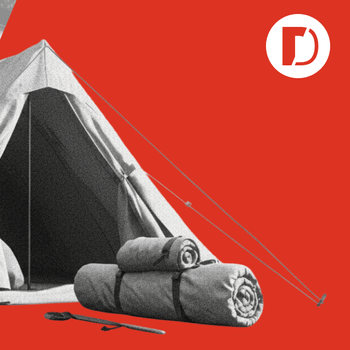14 Psychological Marketing Tips for Customer Mind Control
by Cydney Hatch • September 21, 2018
For centuries. people have been obsessed with the idea of mind control.
From psychological arts, movies and literature throughout time, people love the idea of being able to control other people. The thing is, it’s not all that far fetched!
Mind control is not about magic, old ancient secrets or superhero control like Professor X. Mind control is made a reality through tangible practices called: Marketing & Psychology.

The core of successful marketing is understanding how and why people think and act the way they do. Unfortunately, human behavior isn’t always consistent or rational due to people having their own quirks, but lucky for you, psychology is on your side!
In this article, we’re going to go over 14 psychology-based marketing tips you can use to improve the results of your campaigns today!
Psychology-Based Marketing Tips
Understanding some key principles of psychology can take your marketing from good to amazing because you can understand why content can be compelling to a target audience.
So, to help you attract, connect, and convert more people with your marketing, let’s take a look at some psychologically-proven marketing tips you can try to improve your marketing efforts!
1. The People Mirrors
If one thing is true in this digital age, it’s that emotions run wild on social media.
If you are on Facebook, it’s easy to see that people publicly share emotional responses, even at times fly off the handle from something they read/saw. In essence, we’ve opened up “Pandora’s Box” filled with emotions!

Crazily enough, our feeds are full of “mirrored” feelings according to psychology. The Proceedings of the National Academy of Sciences (PNAS), found that people mirror the positive or negative emotions that their friends express in their posts—all without the aid of nonverbal cues.
Creepy, right?
In fact, Facebook engineers tweaked what 600,000 users saw in their news feeds so they saw more posts that expressed positive emotions, while others saw more posts that conveyed negative feelings. The result: people actually responded to the emotions they saw. Those who saw more “positive” posts responded more positively, while those who saw more “negative” posts responded with negative feelings of their own.
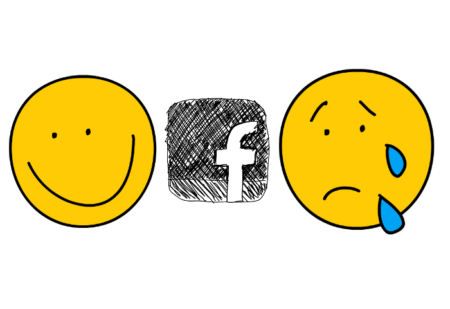
The researchers called this effect an “emotional contagion,” because they claim to show that our friends’ words on our Facebook news feed directly affected our own mood.
So, if you get one person to respond a certain way…you most likely will get their friends to feel that way as well!
2. The Jingle Jam
Have you ever gone through your day with a song stuck in your head? Have you ever heard or watched a commercial you can still remember the jingle to? If so, you have a marketing tip you can use for customers!
Commercial ads are great at creating jingles and sound content to get you to remember the brand.
Take for instance JG Wentworth 877-CashNOW! (I seriously can’t forget this commercial, nor the number)
Their ad featured an opera singer that sang a very compelling jingle that will forever make you want to GET-CASH-NOW.
Breaking this psychology down, we can go back the famous experiment with Pavlov’s dogs highlighting the phenomenon of classical conditioning. Pavlov rang a bell, served his dog with meat, measured the amount of salivation, and repeated this. After several trials, he found that even if he rang a bell and didn’t serve his dog with meat, his dog would still salivate. His dog had created a learned association between the bell ringing and being served meat.
We, as humans, can also be classically conditioned. If you, as a marketer, can create a jingle that gets stuck in everyone’s heads and creates a learned association between the jingle and your brand, then you’re golden.

BAH-BAH-BAH-BAH-BAH…WE’RE LOVIN IT!
3. The Psychology of Color
Color Psychology: the study of hues as a determinant of human behavior (yes, it is a real thing). The psychology of color as it relates to persuasion is one of the most interesting—and most controversial—aspects of marketing.
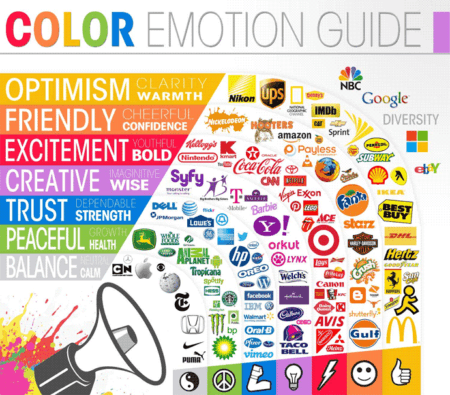
Some people claim it matters, and some people really question its power over people. But since color is an essential part of how we experience the world, we at Disruptive say it matters—especially when it comes to conversion optimization!
Color plays a huge part in our subconscious decision making and a lot of people and brands claim color generalities like:
- Yellow is for Internet “window-shoppers”
- Red creates an emotion of urgency
- Blue promotes trust
- Orange works best for call-to-actions
- Pink is for the ladies
- Black is seen as expensive or for luxury
- Purple calms people down
- Red, orange, black, and light blue are for the impulse buyers
- Dark blue and teal are for the sensible shoppers
- Pink, rose, and very light blue are for “normal” buyers, the guys and gals in between impulse and budget
- Males like bright & ecstatic tints
- Women like soft & soothing shades
But in our experience, the uniqueness of the color and the contrast of it compared to the rest of your site is what really produces results. If you want to know what is the best colors to use for your target audience, we say test it. Do not 100% believe the industry norms, your business is unique as are your customers.
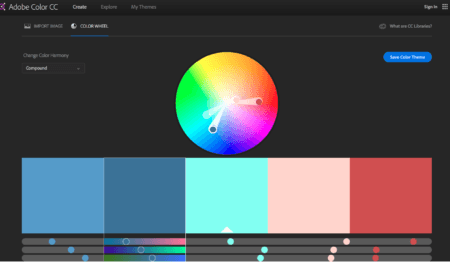
If you also want a pro tip, Adobe has an amazing color wheel that can help you pick harmonious color palettes from complimentary, monochrome or compound! Check it out here!
4. The FOMO Feeling
No matter how much control you think you have, most people make impulse purchases.
How many times have you been compelled to buy something because there were only so many left? No one wants to miss out! Whether it’s the Kylie lip kits that fly off the shelves or signing up for those dang 5K races with your friends that require you to sign up for early bird dates, we all do not want to miss out!
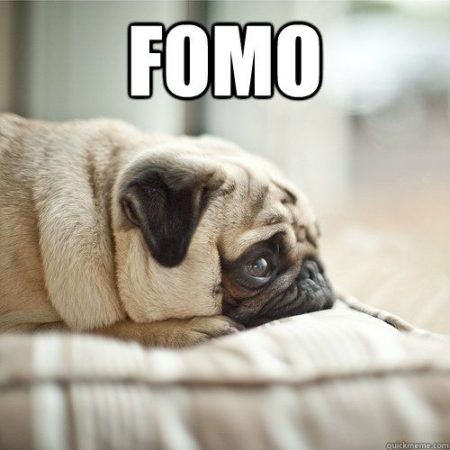
According to psychological research, “the reptilian” brain (the neocortex) expresses itself in: people’s obsessive-compulsive tendencies, the flight-or-fight response and the actions people take in response to urgencies. These are precisely the factors that inspire impulse purchases. It is also a simple perception of scarcity!
So, as a business, you can capitalize on the “impulse buy” phenomenon by asking customers to:
- BUY NOW!
- TRY IT NOW!
- SHOW NOW!
- VIEW NOW!
- GET IT NOW!
- SUBSCRIBE TODAY!
Scarcity and feelings of FOMO are strong motivators! Make use of them by offering limited edition items, limited numbered orders or set deadlines!
5. The Subtle Design
Sometimes people do not love heavy branding, it’s a turn off because in this day of age, people do not want to be sold to. That is why subtle and subliminal messaging can be a strong way to connect your brand to the customer’s brains.
A fantastic example of this is FedEx.
The FedEx logo at first appears simple and straightforward, however, if you look at the white space between the “E” and “x” you can see a right-facing arrow. This “hidden” arrow was intended to be a subliminal symbol for speed and precision.
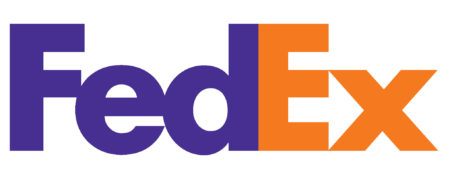 Just like FedEx and a whole slew of other brands, you can use strong subliminal messaging to connect your brand’s ideas creatively with your customers. Supraliminal and subliminal messaging work the same way on the brain: They influence the subconscious.
Just like FedEx and a whole slew of other brands, you can use strong subliminal messaging to connect your brand’s ideas creatively with your customers. Supraliminal and subliminal messaging work the same way on the brain: They influence the subconscious.
Subliminal and supraliminal messages influence purchases and creativity and can even change workplace behaviors. So, as a business look for ways you can promote ideas, branding, and messaging through sounds, smell, design or other “unnoticed” way people can connect the dots.
6. The Sale Mindset
Everyone loves a good sale, but do you ever wonder why it’s hard to resist them? Especially at your favorite store?
In psychology there is a theory called anchoring which states that people base decisions on the first piece of information they receive. An amazing example of this is Bath and Body Works who has this theory down to a science!
Typically their three wick candles go for $25 but every once a blue moon they drop those beloved candles down to $12.95 (it’s happening right now).
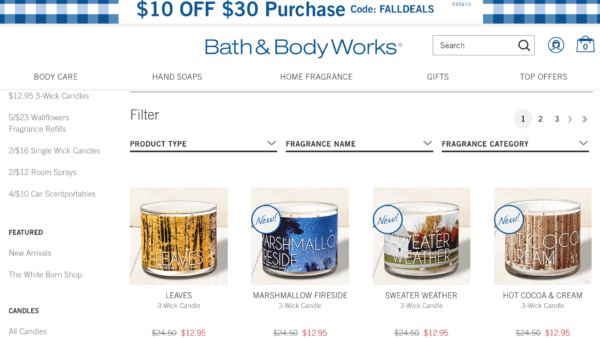
People are ecstatic because they got a crazy good deal! Compare that to someone who just got jeans for 10$ without a baseline price to compare it to…not as fulfilling.
For marketers, anchoring is important to know, especially if you’re ever running a sale. You’ll want to clearly state the initial price of the product (this is “setting” the anchor price), and then display the sale price right next to it. You might even show how much of a percentage off your customers will receive with the sale. It is all about the visuals!
7. The Consistency Comfort
We are creatures of habit so consistency is something we all respond to. In fact, a Princeton study asked people if they would volunteer to help with the American Cancer Society. Of those who received a cold call, 4 percent agreed. A second group was called a few days prior and asked if they would hypothetically volunteer for the American Cancer Society. When the actual request came later, 31 percent agreed.
Like the phone calls, people appreciate consistency in both experience and visuals.
Developing a strong visual brand and experience with your business is key to setting yourself apart from your competitors.
How?
Customers need that trusted experience that they will know, see and feel the same way across all of these interactions! A consistent brand matters because:
- A constant brand looks more professional than one that is all over the place with their marketing.
- When you stay consistent people see you created something, not just something you created for marketing or promotional purposes.
- Customers and clients are more likely to trust a business that presents a professional, authentic, and clear brand image.
An example of this is @FancyTreeHouse, an incredibly popular Instagrammer who is a wonderful example of visual consistency across all of her business platforms. Her branding is incredibly youthful, fun and playful which attracts clients and people who appreciate her styling. Her target audience can trust she will bring the same voice in content, visuals and experiences.

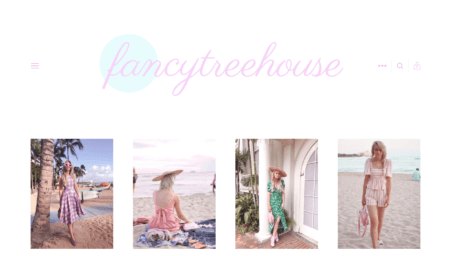
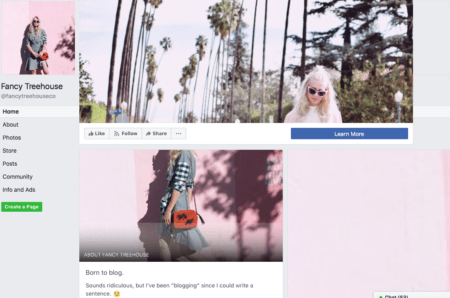
Her feminine, mostly-centered images on pink backgrounds are so identifiable, you know it’s her as soon as she appears in your feed (usually featuring something fluffy, unicorn-inspired or pastel). Her pairings of color and silhouettes are so eye-catching!
Consistency doesn’t mean you have to post the exact same thing over and over again. Your audience will quickly lose interest without variety! What will work is having a selection of colors, themes and ideas that all fit within a brand.
By being consistent, your customers will be able to pick your business posts out quickly, will be able to process it and feel safe in knowing you are consistent across all of your platforms which leads to less friction.
8. The Need of Images
Did you know that people remember 80% of what they see, and just 20% of what they read? The power of an image is hard to ignore, and if you’re not including great images of your products on your ecommerce website, you could be missing out on some serious sales.
Don’t believe me? Look at these stats:
- “38% of people will leave a website if they find the layout unattractive or difficult to navigate”
- “Given 15 minutes to consume content, two-thirds of people would rather read something beautifully designed than something plain”
- “Google: 53% of mobile users abandon sites that take over 3 seconds to load”
Do whatever is possible to amplify your visual content, create powerful product images and front-load images within your website. Sites with a powerful visual impact have greater marketing success.
An awesome example of this is Bryan Anthony Jewelry. They created a beautiful ad sponsoring their bridal line on Pinterest. What is amazing about the ad:
- Quality Photography
- Stylized for Target Audience
- Line Use of Necklace Leads You To Ad Copy
- Limited Ad Copy
- Clear Call To Action Button
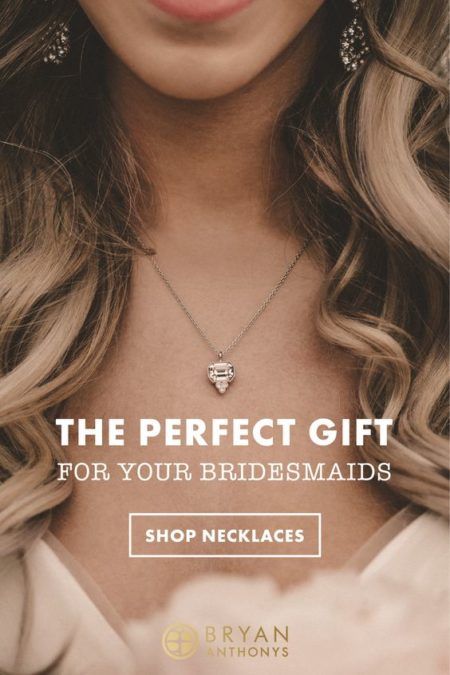
This ad does a lot of the “talking” as a customer can see a beautiful bridesmaid necklace they can picture their wedding party in. Like this shot, lifestyle shots in your business content are the photos that help inspire your customers to purchase and make them feel like they “need” to have the product in their own personal lives.
I call these the “Steve Irwin” of product photography because you are showcasing your products in their natural habitat—the way they are intended to be used/look.
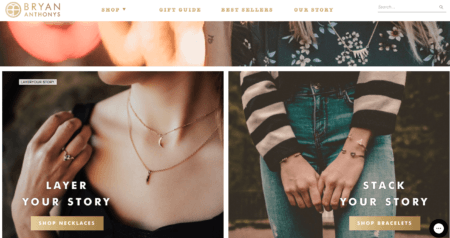
In addition to the ad, Bryan Anthony continues to use strong lifestyle photography to sell their products to customers with little text throughout their brand experience.
Like them and many other businesses, do not lose customers with too much text! We live in a visually charged world, so do not miss out!
9. The Serial Exposure
Mere exposure theory states that the more people see something, the more they will like it.
Exposure is everything.

I can personally attest to this. When skinny jeans became a thing in 2002… I swore I would never give up my bell bottoms, but of course, we all know I eventually did…how and why did this happen?
Apparently, the simple act of repeated exposure automatically triggers a positive association in our brains. ChangingMinds.org reports: “The more exposure we have to a stimulus, the more we will tend to like it. Things grow on us and we acquire tastes for things over time and repeated exposure.”
Familiarity increases our likelihood of adapting and liking something.
So how can you make this work? Keep your business in front of your potential customer’s brains! Regular advertisements, retargeting and email communication are great ways you can promote positive associations. Be sure to find the proper balance, though, as you do not want to over-saturate!
10. The Power of Choice
A lot of the time, potential customers are like three-year-olds: they want independence!
By transferring the power to the customer and putting their personal choice first, brands are opening the door to a more democratic relationship that will prove to be long-lasting. An important key to keep is that when it comes to what you present, too many options might be a bad thing.
According to a study at Stanford, there’s a point when choices actually start to demotivate. Customers might want to see all of the options available, but that’s ultimately going to prevent them from making a decision.
So, when setting up a page with options or pricing, be sure to strategize and select a few. For example, shorter restaurant menus are gaining in popularity. A great example of this is Pretty Bird Chicken in SLC Utah.
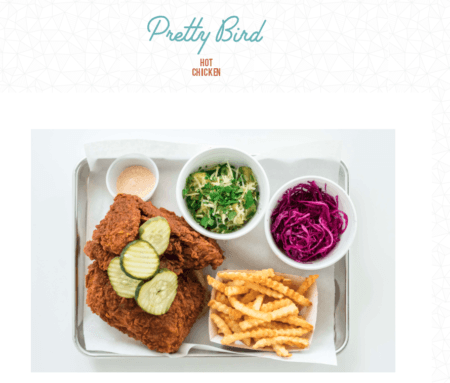
By having only four items on the menu and a select list of sides/extras this psychology marketing tip leaves customers feeling more fulfilled and happy with their choices.
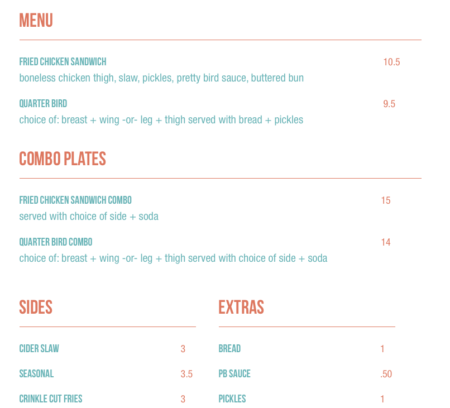
Restaurants recognize that offering too many choices makes it hard for diners to make a choice. This results in diner confusion. It also increases table turnover time as diners spend extra time looking through large menus. With shorter menu, it is easier for customers to remember why they visit a particular restaurant.
Like the restaurant business and the drive for Millenials to chose quality over quantity, it will be important to show you specialize in quality products and services by offering less. Less is sometimes more!
11. The Emotion Message
In today’s digital age, emotion usually trumps intellect (no, that is not a Donald Trump joke).

One of the most valuable rules for consumer behavior in psychology is that people respond better to emotional appeals than intellectual ones.
Antonio D’Amasio, professor of neuroscience at the University of Southern California, asserts that emotion is an integral element of the decision-making process: “…emotion is a necessary ingredient to almost all decisions. When we are confronted with a decision, emotions from previous, related experiences affix values to the options we are considering. These emotions create preferences which lead to our decision.”
So, feelings are not just hunches, it’s how people process information! In fact, Roger Dooley’s article “Emotional Ads Work Better” reveals that emotional ad campaigns perform nearly twice as well as ads with a rational focus.
Why?
It’s more persuasive to show consumers how a product or service can benefit their life in a meaningful way rather than showing them a list of features. So, for example, Zooey Dechanel is an actress many modern women relate to and Apple had her do an incredibly cute commercial featuring the 4S Siri app.
https://www.youtube.com/watch?v=fbEjCvdGaZU
How relatable right? (I mean putting on real shoes is a struggle!)
Ordering in tomato soup, comfy PJS, and dancing on rainy days in? I think we all feel a bit more cozy and happy watching the commercial! Apple wanted women to feel like they could be themselves while using this product and that they can make their home life a lot easier, independent and comfortable.
On a more masculine note, Old Spice does a great job connecting “emotionally” with their male audience.
Let’s get real, men do not like talking or expressing emotions all that much. So, how can you connect emotionally with a demographic that won’t resonate with warm fuzzies? Old Spice has the manliest of men, Terry Crews, yelling at you with all the rage a hyped up man could have about something but is so outlandish it takes the awkwardness of emotion out and makes men laugh. The laughs defuse their emotional barriers to connect and allow a message to be received.
By Old spice not pushing their products in these ridiculous commercials, it makes men want to support something they enjoyed.
Like these two ads, make the connection between experiences and feelings your potential customers will have! When we understand that emotions inform our decisions through their linked associations, it becomes easier to see how you can use this information when planning your marketing strategy.
Start by doing your research. What associations will create positive emotions for your demographic audience? Conversely, what do they dislike or fear? Then, build a campaign that helps your unique audience envision how your product or service will directly benefit their life on an emotional level
If you can emotionally connect, you have marketing gold!
12. The Created Community
People want to make a difference in the world and many want to be apart of a cause/community. Whether that is a religion, social change motion, politics, or family we all want to belong.
As a marketer, there is a marketing tip we can use from this!
Goldstein, Cialdini, and Griskevicius conducted a study on Using Social Norms to Motivate Environmental Conservation in Hotels. In this study, they tried to determine what kind of message would get hotel guests to reuse their towels. They used three variations, paraphrased below:
- Standard message: ‘help save the environment’
- 75% of hotel guests in this hotel reuse their towels
- 75% of hotel guests in this room reuse their towels
The messages that talked about participating and mentioned other guests actions increased reuse of towels by 10-15%. Another example of this is Aerie’s #AerieREAL campaign, which encourages women of all sizes to feel comfortable in their own skin, is a major drive for revenue. The movement positively impacts society while simultaneously marketing the brand.
This phenomenon where people tend to view others who are similar to them more favorably is called in-group favoritism or social herding.
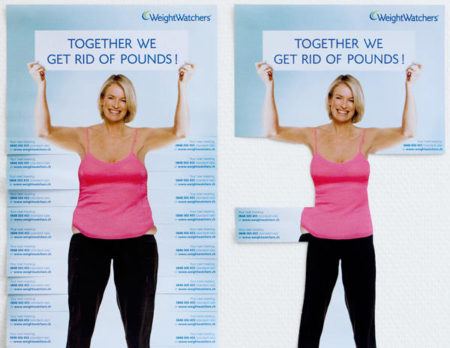
All in all, the best way to motivate your customers to do something is to say that customers do the same thing. It is the same reason why people do not tend to speak up in groups, its a group mentality.
So for example, you could use social proof testimonials, mention statistics and data you have found between your “audience” or even create a literal community with memberships etc.
Try to find common ground and draw similarities among your customers as it will pay off in your content.
13. The Give and Get
Have you ever been caught off guard by a surprise gift at Christmas when you haven’t gotten that person a gift in return?
I know my mother always prepped every Christmas season with ornaments she could quickly exchange with random gift stoppers-bye. Now, a lot of you might not be like my mother, and will then be left empty handed telling the person, “I do not have anything for you.”

This discomfort is the psychological principle of “reciprocity”.
Reciprocity is the idea that we want to do nice things in return when people do nice things for us. In 1974, a sociologist from Brigham Young University, Philip Kunz, sent roughly 600 Christmas cards to folks he had never met. To his surprise and delight, roughly 200 strangers wrote back.
What does this tell us? We as a people feel obligated to give back to others when they have first given to us. Gift giving is a cultural phenomenon throughout the world and apparent in many cultures.
As a business, you can monopolize on this dire need to give back by offering customer’s a small gift that is not contingent on a purchase. This can be a free sample you give when a customer first walks into the storefront or a pop up discount code for just visiting your site.
Be creative with your gifts and make sure that they are an item that will be of use to your demographic.
14.The Power of Three
If you notice, things are always best in odd numbers when it comes to design, stories or whatever really. My mother always told me to do things in either 3, 5 or 7 when it comes to most things.

Like this visual trick, you’ll often see this effect of three in pricing models. One price point is intentionally included to entice you to choose the most expensive option.
In Dan Airley’s famous TED talk, “Are we in control of our own decisions?”, he describes an ad from The Economist outlining their latest subscription packages. Here’s what they offered:
- Online subscription: $59
- Print subscription: $125
- Online and print subscription: $125
He decided to run his own study with 100 MIT students. He gave them the pricing packages outlined above and asked which one they’d want to buy. When all three options were there, students chose the combo subscription—it was the best deal, right? But when he removed the “useless” option (the print subscription for $125), the students preferred the cheapest option.
Turns out that middle option wasn’t that useless after all—it gave students a frame of reference for how “good” the combo deal was and enticed them to pay more for that deal.
So, if you’re looking to increase conversions on a landing page with two options, you might want to add a third. It could help increase the conversion rate of the option you’d ultimately want people to take.
Mind Control Engaged!
I hope you found some of these psychological marketing tips to be helpful!
Of course, this barely scratches the surface.

Psychology is a deep and eternally revealing line of study. And while I don’t believe in making things more complicated than they have to be, there is great benefit in knowing not only what people do, but also why they do it.
If you use psychology to your advantage, you’ll find it easier to make sure your marketing is effective. Now that you have these awesome tricks up your sleeve, be sure to use your powers for good. If you want some more help with marketing tips, testing and how to best craft your marketing content towards your target audience, let me know in the comments!
What do you think? Do you believe psychology has a place in marketing? If so, which psychology marketing tips do you think businesses should focus on? Comment below, I would love to hear your thoughts!





